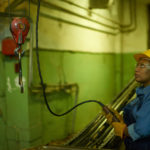10 Common Crane and Hoist Terms Defined

When it comes to overhead cranes and hoists, there’s a lot of industry terminology. Here are ten common crane and hoist terms and their definitions so you can be an industry expert with the vocabulary to prove it.
Axial Load
The axial load refers to the total vertical force on the supporting structure in a jib crane. To calculate this figure, you multiply the design factor by the weight of the load, and then add the overall weight of the crane.
Axial load = (overall weight of the crane) + (design factor * weight of load)
Box section
The box section is the rectangular cross section where girders, trucks or other members meet. It is made of two rolled steel side plates, a top plate and a bottom plate.
Drag brake
A drag brake is a locking system which does not require external force to provide retarding force.
Explosion-proof crane
An explosion-proof crane is created with specially constructed electrical components. These components prevent the ignition of hazardous materials in the surrounding atmosphere by containing any explosions that may occur within the components.
Lift / Lift height
The lift height is the maximum vertical distance from the floor that the hook, magnet or bucket can safely move.
Height Under Boom (HUB)
The HUB measures the distance from the floor to the underside of the boom of a jib crane. To calculate the minimum HUB is add the height of the load to the maximum distance the load is to be lifted, plus the headroom required for the hoist, trolley and attachments.
Height Under Boom = load height + maximum distance load is to be lifted + required headroom
Two blocking
Two blocking is when the load block or load suspended from the hook is jammed against the crane or hoist structure. This prevents the hoist drum or chain pocket wheel from further winding up.
Web plate
The vertical plate that connects the upper and lower flanges or cover plates of a girder is the web plate.
Wheel load
The wheel load is the amount without any impact or vertical inertia force on any wheel with the trolley and lifted load (rated capacity) positioned on the bridge to drive maximum loading.
Trolley
The trolley carries the hoist across the bay along the bridge girder, jib boom, gantry or monorail beam. A trolley hoist is the unit that consists of both the hoist and the trolley frame.
If you have an upcoming job and you can’t decide whether a crane or a forklift would work best, we’ve created an easy comparison between cranes and forklifts so you can choose the tool that’s best for your project.










